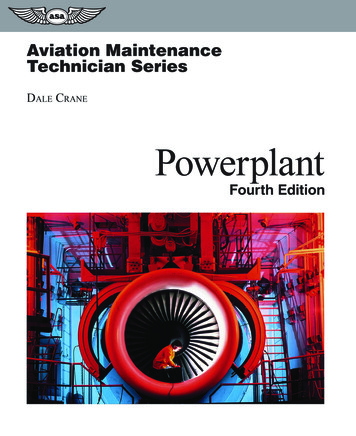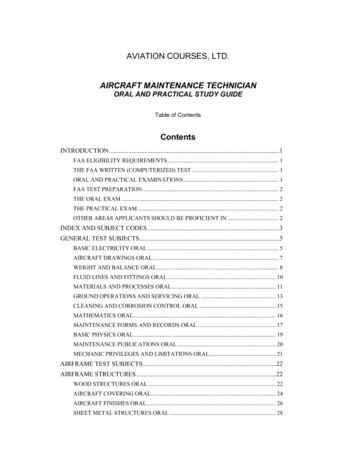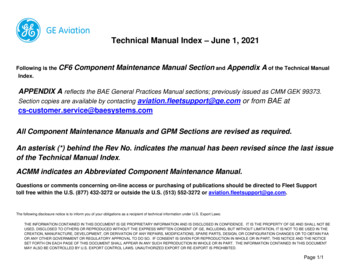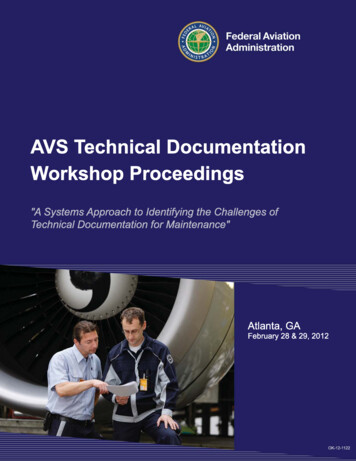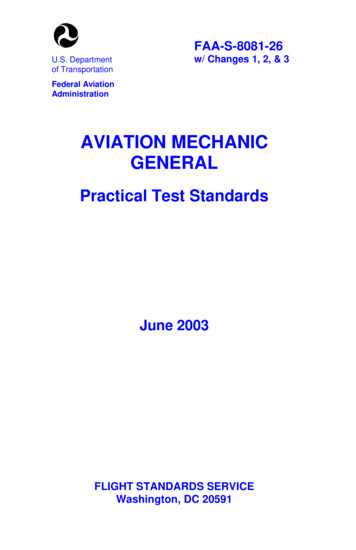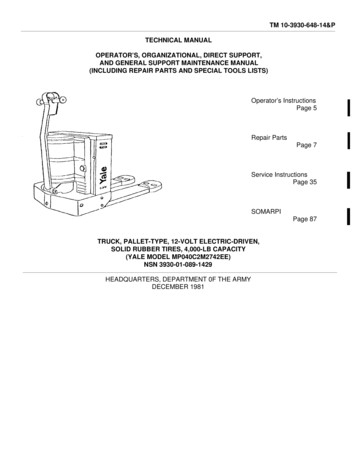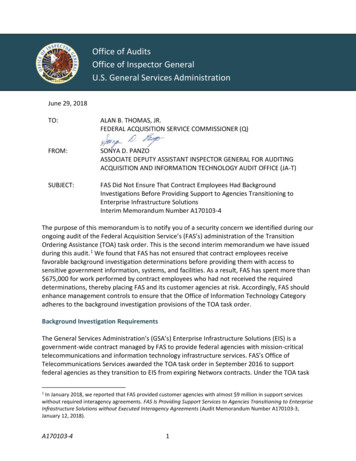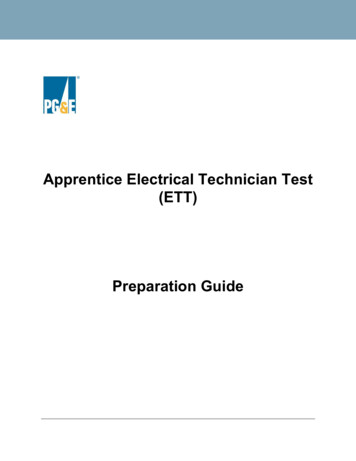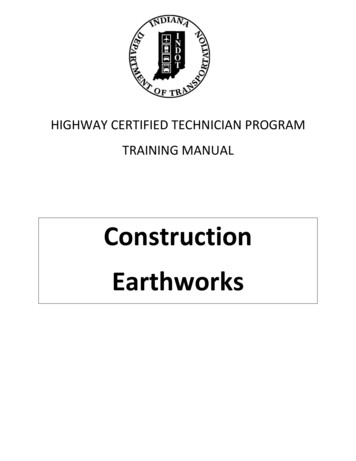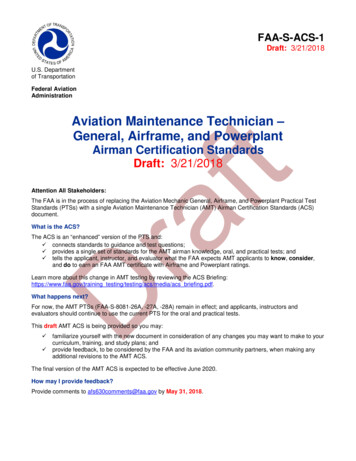
Transcription
FAA-S-ACS-1Draft: 3/21/2018U.S. Departmentof TransportationFederal AviationAdministrationAviation Maintenance Technician –General, Airframe, and PowerplantrafAttention All Stakeholders:tAirman Certification StandardsDraft: 3/21/2018The FAA is in the process of replacing the Aviation Mechanic General, Airframe, and Powerplant Practical TestStandards (PTSs) with a single Aviation Maintenance Technician (AMT) Airman Certification Standards (ACS)document.What is the ACS?The ACS is an “enhanced” version of the PTS and: connects standards to guidance and test questions; provides a single set of standards for the AMT airman knowledge, oral, and practical tests; and tells the applicant, instructor, and evaluator what the FAA expects AMT applicants to know, consider,and do to earn an FAA AMT certificate with Airframe and Powerplant ratings.DLearn more about this change in AMT testing by reviewing the ACS Briefing:https://www.faa.gov/training testing/testing/acs/media/acs briefing.pdf.What happens next?For now, the AMT PTSs (FAA-S-8081-26A, -27A, -28A) remain in effect; and applicants, instructors andevaluators should continue to use the current PTS for the oral and practical tests.This draft AMT ACS is being provided so you may: familiarize yourself with the new document in consideration of any changes you may want to make to yourcurriculum, training, and study plans; andprovide feedback, to be considered by the FAA and its aviation community partners, when making anyadditional revisions to the AMT ACS.The final version of the AMT ACS is expected to be effective June 2020.How may I provide feedback?Provide comments to afs630comments@faa.gov by May 31, 2018.
FAA-S-ACS-1FAA-S-ACS-1U.S. Departmentof TransportationFederal AviationAdministrationAviation Maintenance Technician –tGeneral, Airframe, PowerplantDrafAirman Certification StandardsEffective Date: TBDFlight Standards ServiceWashington, DC 20591
AcknowledgmentsThe U.S. Department of Transportation, Federal Aviation Administration (FAA), Airman Testing StandardsBranch, P.O. Box 25082, Oklahoma City, OK 73125, developed this Airman Certification Standards (ACS)document with the assistance of the aviation community. The FAA gratefully acknowledges the valuable supportfrom the many individuals and organizations who contributed their time and expertise to assist in this endeavor.AvailabilityThis ACS is available for download from www.faa.gov. Please send comments regarding this document toAFS630comments@faa.gov.DraftMaterial in FAA-S-ACS-1 will be effective TBD. All previous editions of the Aviation Mechanic General, Airframe,and Powerplant Practical Test Standards (FAA-S-8081-26, -27, and -28) will be obsolete as of this date forAviation Maintenance Technician applicants.i
ForewordThe FAA has published the Aviation Maintenance Technician (AMT) – General, Airframe, Powerplant ACSdocument to communicate the aeronautical knowledge, risk management, and skill standards for AMTcertification. This ACS incorporates and supersedes the previous editions of the following documents: FAA-S-8081-26A, Aviation Mechanic General Practical Test Standards (with Change 1, dated 4/27/15); FAA-S-8081-27A, Aviation Mechanic Airframe Practical Test Standards (with Change 1, dated 4/27/15,and Change 2, dated 9/29/15); FAA-S-8081-28A, Aviation Mechanic Powerplant Practical Test Standards (with Change 1, dated4/27/15); and FAA-G-8082-3A, Aviation Maintenance Technician-General, Airframe, and Powerplant Knowledge TestGuide (dated September 2008).tThe FAA views the ACS as the foundation of its transition to a more integrated and systematic approach toairman certification. The ACS is part of the safety management system (SMS) framework that the FAA uses tomitigate risks associated with airman certification training and testing. Specifically, the ACS, associated guidance,and test question components of the airman certification system are constructed around the four functionalcomponents of an SMS:Safety Policy that defines and describes aeronautical knowledge, risk management and skill as integratedcomponents of the airman certification system; Safety Risk Management processes through which both internal and external stakeholders identifychanges in regulations, safety recommendations, or other factors. These changes are then evaluated todetermine whether they require modification of airman testing and training materials; Safety Assurance processes to ensure the prompt and appropriate incorporation of changes arising fromnew regulations and safety recommendations; and Safety Promotion in the form of ongoing engagement with both external stakeholders (e.g., the aviationmaintenance and training industry) and FAA policy divisions.raf DThe FAA has developed this ACS and its associated guidance in collaboration with a diverse group of aviationtraining experts. The goal is to drive a systematic approach to all components of the airman certification system,including knowledge test question development and conduct of the oral and practical test. The FAA acknowledgesand appreciates the many hours that these aviation experts have contributed toward this goal. This degree ofcollaboration, a hallmark of a robust safety culture, strengthens and enhances aviation safety at every level of theairman certification system.John S. DuncanDirector, Flight Standards Serviceii
Revision HistoryDescriptionRevision DateFAA-S-8081-26AAviation Mechanic General Practical Test Standards(Change 1)April 27, 2015FAA-S-8081-27AAviation Mechanic Airframe Practical TestStandards (Changes 1 and 2)September 29, 2015FAA-S-8081-28AAviation Mechanic Powerplant Practical TestStandards (Change 1)April 27, 2015FAA-S-ACS-1Aviation Maintenance Technician – General,Airframe, and Powerplant Airman CertificationStandardsTBDDraftDocument#iii
Table of ContentsIntroduction . 1Airman Certification Standards Concept . 1Using the ACS. 1I.General. 3A. Fundamentals of Electricity and Electronics . 3B. Aircraft Drawings . 5C. Weight and Balance . 6D. Fluid Lines and Fittings. 7E. Aircraft Materials, Hardware, and Processes . 8F. Ground Operations and Servicing . 9G. Cleaning and Corrosion Control . 11H. Mathematics . 13tI. Regulations, Maintenance Forms, Records, and Publications . 14J. Physics for Aviation . 16rafK. Inspection Concepts and Techniques . 17L. Human Factors . 18II. Airframe Structures . 19A. Metallic Structures . 19B. Non-Metallic Structures . 21C. Flight Controls . 23D. Airframe Inspection . 24III. Airframe Systems . 25A. Landing Gear Systems . 25B. Hydraulic and Pneumatic Systems . 27DC. Environmental Systems . 28D. Aircraft Instrument Systems . 29E. Communication and Navigation Systems . 31F. Aircraft Fuel Systems . 33G. Aircraft Electrical Systems. 34H. Ice and Rain Control Systems . 36I. Airframe Fire Protection Systems . 37J. Rotorcraft Fundamentals . 38IV. Powerplant Theory and Maintenance . 39A. Reciprocating Engines . 39B. Turbine Engines . 40C. Engine Inspection . 41V. Powerplant Systems and Components . 42A. Engine Instrument Systems . 42B. Engine Fire Protection Systems . 43iv
C. Engine Electrical Systems . 44D. Lubrication Systems . 45E. Ignition and Starting Systems . 46F. Fuel Metering Systems . 47G. Engine Fuel Systems . 48H. Engine Induction Systems . 49I. Engine Cooling Systems . 50J. Engine Exhaust and Reverser Systems. 51K. Propellers . 52DraftAppendix Table of Contents . 54v
IntroductionAirman Certification Standards ConceptThe goal of the airman certification process is to ensure the applicant possesses the knowledge, ability to managerisks, and basic skills consistent with the privileges of the certificate or rating being exercised. The AirmanCertification Standards (ACS) concept forms a more comprehensive standard for what an applicant must know,
31.05.2017 · Federal Aviation Administration . Aviation Maintenance Technician – General, Airframe, and Powerplant . Airman Certification Standards . Draft: 3/21/2018 . Attention All Stakeholders: The FAA is in the process of replacing the Aviation Mechanic General, Airframe, and Powerplant Practical Test

